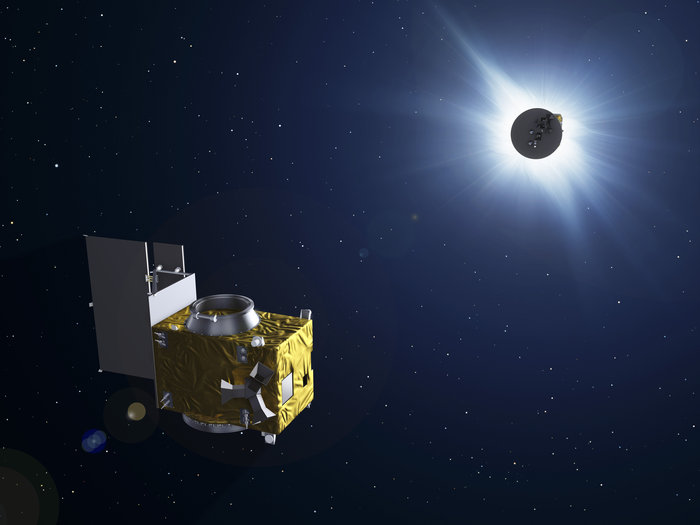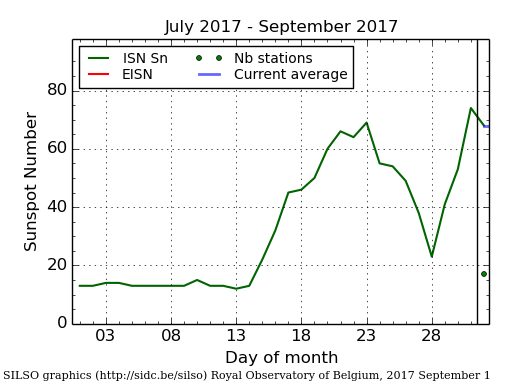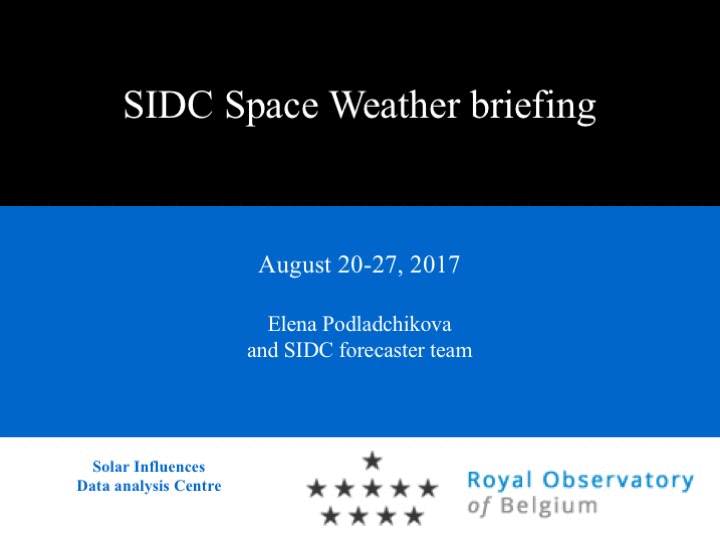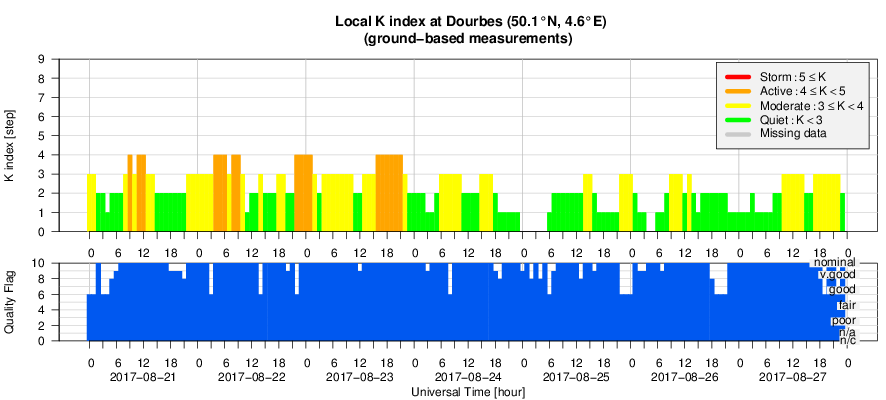- Table of Content
- 1.To look where ...
- 2.Review of sola...
- 3.The Internatio...
- 4.Geomagnetic Ob...
- 5.SIDC Space Wea...
- 6.Future Events
2. Review of solar and geomagnetic activity
3. The International Sunspot Number
4. Geomagnetic Observations at Dourbes (21 Aug 2017 - 27 Aug 2017)
5. SIDC Space Weather Briefing
6. Future Events
To look where no man looked before
The ultimate eclipse machine - PROBA-3
A total solar eclipse like the one we had on August 21 offers a great opportunity to study solar corona, the part of the solar atmosphere just above the solar surface. This region is the source of the solar wind, an ever-lasting flow of particles blown by the Sun into space. It is also where magnetic plasma clouds that are ejected by the Sun are accelerated. These clouds are thrown into the solar wind and might come into our direction causing a magnetic storm in the Earth’s environment.
That’s why we are very eager to have a closer look into this particular region. Instead of waiting until the next solar total eclipse, we thought it would be more efficient to create our own eclipses. An idea was born and is by now almost completely materialised in the form of an extraordinary space mission called satellite PROBA-3. PROBA-3 is a duo-satellite: one satellite will occult the solar disk such that thea second satellite which is in the shadow of the occulting satellite at a distance of 150 m, has an amazing view on the solar atmosphere corona during 6 hours every 20-hour satellites orbit. The occulter is just big enough to cover precisely the solar disk. Yes, your thinking is correct: this requires an amazing very accurate positioning of both satellites during their flight.

PROBA-3 is the ultimate state-of-the-art eclipse-producing machine guaranteeing exciting research of the solar atmosphere. An eclipse- maker is called a coronagraph. This coronagraph listens to the name ASPIICS.
Andre Andrei Zhukov, STCE researcher and Principal Investigator of ASPIICS: ‘Finally, we can look for during long periods at the region where it all happens. Where the never- lasting solar wind is generated, which carries massive plasma clouds into space. I’m looking forward to 2020 when PROBA-3 will be launched!’
PROBA-3 will look where no researcher has looked before during very long uninterrupted periods.
Review of solar and geomagnetic activity
SOLAR ACTIVITY
NOAA Active Region 2671 and 2672 were responsible this week for the flaring activity.
NOAA AR 2672 rotated over the east limb on August 20 and produced numerous C-class flares during the course of the week. On August 20 it produced a C9.4 flare peaking at 19:39 UT, this was the strongest flare of the week. On August 21 it was the source of a C5.9 flare peaking at 03:16 UT, on August 25 a C5.5 flare peaking at 07:27 UT. The region grew in size and complexity as it evolved into beta gamma configuration by August 24 and was labeled as beta by the end of the week.
NOAA AR 2671, with a beta gamma configuration throughout the entire week, produced numerous B-class flares and a few low intensity C-class flares. Its strongest flare was a C6.3 flare on August 27 peaking at 15:16 UT, just before is rotated over the west-limb.
No Earth-directed CMEs were observed.
GEOMAGNETIC ACTIVITY
Earth was under the influence of a high speed stream in the beginning of the week. The interplanetary Kp index reached moderate storm level during 00-03 UT on August 22 due to an increased solar wind speed of around 650 km/s in combination of negative values of the Bz component of the Interplanetary Magnetic Field (up to -9 nT) during a long time interval of negative value of the Bz component of the interplanetary magnetic field. Two minor storm episodes have been also observed on August 23 (at 00 and 06 UT).
The solar wind parameters returned after the passing of the high speed stream to nominal values. The geomagnetic conditions remained quiet.
The International Sunspot Number

The daily Estimated International Sunspot Number (EISN) is derived by a simplified method from real-time data from the worldwide SILSO network. It extends the official Sunspot Number from the full processing of the preceding month (green line). The plot shows the last 30 days (about one solar rotation). The horizontal blue line shows the current monthly average, while the green dots give the number of stations included in the calculation of the EISN for each day.
In this particular graph, there is only 1 value for the EISN. The red line is covered by the blue line and therefore not visible.
SIDC Space Weather Briefing

The Space Weather Briefing presented by the forecaster on duty from Aug 21 till 27. It reflects in images and graphs what is written in the Solar and Geomagnetic Activity reports.
Future Events
For more details, see http://www.spaceweather.eu/en/event/future
Workshops on Radiation Monitoring for the International Space Station in Torino, Italy
Start : 2017-09-05 - End : 2017-09-07
The Workshop on Radiation Monitoring for the International Space
Station is an annual meeting to discuss the scientific definition
of an adequate radiation monitoring package and its use by the
scientific community on the ISS. Types of instruments and research
topics need to be defined in order to optimise the radiation safety
of the ISS crew.
Website: http://wrmiss.org/
International Workshop on Solar, Heliospheric & Magnetospheric Radioastronomy in Meudon, France
Start : 2017-11-06 - End : 2017-11-10
Jean-Louis Steinbeg has been one of the major pioneers in
radioastronomy. Co-founder of the Nançay Observatory, he
has actively participated to, an inspired a large number of radio
instruments on many international space missions. Jean-Louis
Steinberg is the founder of the Space Radioastronomy laboratory of
the Paris Observatory in 1963. Later on, this laboratory widened
its science interests and became the DESPA (1971) and then the
current LESIA (2002) which is one of the major space sciences
laboratories in France. The aim of this workshop is to cover the
science topics which Jean-Louis Steinberg has promoted during his
career, focusing on Solar, Heliospheric & Magnetospheric
radioastronomy & physics. This will be done by covering both
observations from either ground facilities (NDA, RH, LOFAR, Artemis
etc ...) or space missions (ISSEE, Ulysses, WIND, CLUSTER, STEREO,
CASSINI, JUNO etc ...) and models/theories. A series of invited
talks is also foreseen to cover the new developments in the
discipline which may come with the future facilities such as Solar
Orbiter, Solar Probe Plus, JUICE, JUNO, LOFAR+, SKA etc ....
This workshop will also be the opportunity to remember both the
extraordinary personal & professional lifes of Jean-Louis
Steinberg especially for new generation of scientists. At the
occasion of this workshop it is also expected that the Building 16
(historical Space Sciences building) on the Meudon campus will be
renamed "Building Jean-Louis Steinberg".
Website:
https://jlsworkshop.sciencesconf.org/
European Space Weather Week 14
Start : 2017-11-27 - End : 2017-12-01
The ESWW is the main annual event in the European Space Weather
calendar. It is the European forum for Space Weather as proven by
the high attendance to the past editions. The agenda will be
composed of plenary/parallel sessions, working meetings and
dedicated events for service end-users. The ESWW will again adopt
the central aim of bringing together the diverse groups in Europe
working on different aspects of Space Weather.
Website:
http://www.stce.be/esww14/
